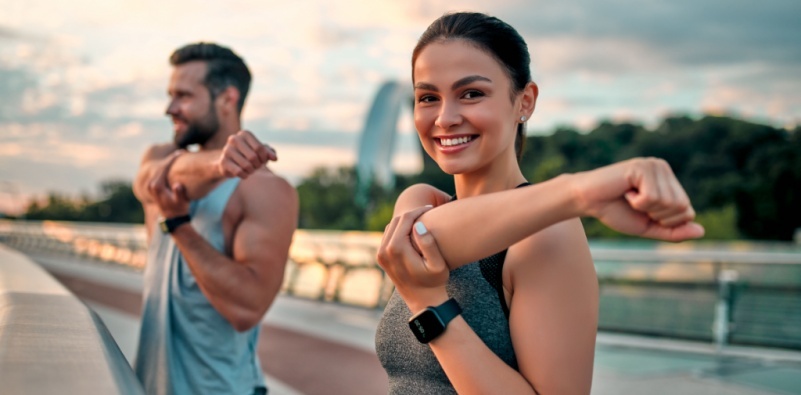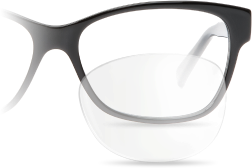What’s the link between exercise and eye health?

April is Move More Month, so we’re looking at how exercise and eye health are linked. Did you know that doing just 30 minutes of exercise a day could help improve your eye health alongside your mental and overall body health? No matter which form of exercise you prefer, be it running, walking, swimming, cycling, or even dancing, these are all great activities to get stuck into!
How exercise can affect eye conditions

If you have an eye condition, you’ll be interested to know that you can introduce certain exercises for eyes to protect your vision. Daily exercise is still crucial for those of you without eye conditions to help reduce your chances of developing them. So, what are the specific eye conditions for which exercising can help reduce the risk?
Glaucoma
Glaucoma is when fluid builds up in the eye, increasing internal pressure and damaging the optic nerve connecting the eye to the brain. Studies have shown that when people with glaucoma exercise regularly for 3 months, their eye pressure can be reduced by up to 20%.
If you don’t have glaucoma, exercising can help reduce the risk of developing the condition by 25%. This means a greater chance of preventing vision loss in the future. Low-impact exercises such as yoga and swimming are great options to start your journey to better health and glaucoma outcomes.
Cataracts
A cataract is when the eye’s lens becomes cloudy, making your vision hazy or blurry. Regular exercise can reduce oxidative stress in the eye and reduce the chance of developing cataracts. Research shows there is a potential for the risk of developing cataracts to reduce by 2% every hour when you walk or cycle every day.
Age-related macular degeneration (AMD)
AMD is an eye disease that affects the central vision and is one of the leading causes of vision loss in people aged 60 and over. It is caused by light-sensitive cells at the back of the eye breaking down and not working. The good news is that regular exercise can reduce the risk of developing AMD by up to 70%. Whether you take a brisk walk everyday, go cycling, swimming, or do water aerobics, you’ll be giving your eyes a fighting chance to avoid developing this irreversible eye condition.
Diabetic retinopathy
Diabetes can be linked to several conditions, including diabetic retinopathy, which can lead to loss of vision due to uncontrolled high blood sugar levels. For people with type 2 diabetes, regular exercise can help in several ways. For starters, exercise can lower your risk of developing diabetes in the first place. If you have diabetes, exercising regularly can help to reduce your dependence on medication and improve your body’s insulin sensitivity.
Get exercising

We’ve already mentioned some more common ways to exercise, such as running and swimming, but there are many other ways to get your body moving. Playing sports, even if it’s just with a few friends, is one great option. You could also take a class in aerobics, spinning, or Zumba. There’s also the option of exercise machines, such as a treadmill or elliptical, either at the gym or in your home. Anything that increases your heart rate will benefit you in the long run!
If you’re exercising outdoors, you’ll need a good pair of sunglasses to protect your eyes from the sun’s harmful rays and ensure optimum vision. We stock men’s and women’s sunglasses and offer a replacement lens service if you want high quality sunglasses lenses fitted into your existing frames, with various tints and treatments like a polarized filter to choose from.
Physical exercise can also improve blood pressure and cholesterol levels and strengthen your heart health, all of which has a direct impact when it comes to exercise and eye health.
Specific exercises for eyes
While general physical exercise is great for eye health, there are specific exercises you can do for your eyes, too. If you have certain problems with your eyes such as a lazy eye, crossed eyes, or issues with depth perception, your eye doctor may prescribe special exercises to help. However, everyone can benefit from doing some quick and easy exercises for eyes to help relieve symptoms of eye strain, headaches, and fatigue of the eyes.
Follow the 20-20-20 rule
If you’re concentrating on close work, on a screen, a book, if you’re making something, it’s important to give your eyes regular breaks. Focusing at this distance for too long can lead to eye strain and headaches, so we recommend following the 20-20-20 rule. Every 20 minutes, look at something 20 feet away for 20 seconds. This gives your eyes a break and will also help you to maintain focus.
Keep blinking
When looking at a screen, you blink less, which can cause the surface of your eyes to become dry. This can feel uncomfortable, making your eyes sore, so try to make sure you blink frequently to lubricate your eyes.
Palm relaxation
If your eyes are feeling tired or strained, a nice way to relax them is to gently place your palms over your closed eyelids. Hold this position for around 30 seconds until any afterimages have faded and all you see is black. Make sure you cup your palms when you do this so you don’t put any pressure on your eyes.
Figure 8
Another great and easy exercise to strengthen your vision is the figure 8. Pick an area about 10 feet in front of you to focus on, and imagine a big number 8 on its side. Follow the line of the figure 8 with your eyes slowly for around 30 seconds, then pause and switch to follow the line the opposite way for the same amount of time.
Get advice for exercise and eye health
If you have concerns about your eye health or need more detailed advice, the best thing to do is to contact your local eye doctor. They can discuss your concerns and advise you on the best course of action. In the meantime, we hope you’ve taken away some good tips to get you started – happy exercising!






















